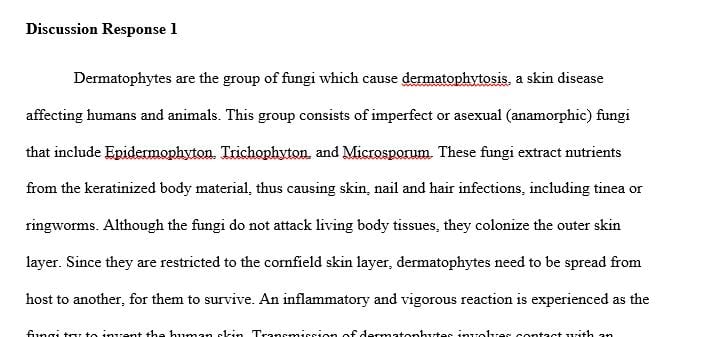Choose any one of the fungal pathogens and discuss its appearance, staining reaction
Fungal Pathogens
Choose any one of the fungal pathogens and discuss its appearance, staining reaction, culture characteristics, disease caused, and epidemiological characteristics (where is it common, who is at risk).
DISCUSSION POST #1
Hello Prof and Classmates,
Dermatophytosis is a fungal disease of the hair, skin, or nails. It is also commonly known as tinea infections to which it composes several forms of ringworm such as athlete’s foot. It is called ringworm because can causes a circular rash that is shaped like a ring that is usually red and itchy. Signs and symptoms would be blister like lesions. The fungi that cause this infection can live on skin, surfaces, and on household items such as towels, clothing, and bedding. The names for the types of fungi that cause ringworm are Trichophyton, Microsporum, and Epidermohyton. There are three ways that ringworm can spread and that is through from contact with someone who has ringworm, from animal that has ringworm, or from the environment. Ringworm is common and anyone can get the fungal disease. Although people who have weakened immune systems may be at risk for infection and may encounter problems fighting off the infection. The treatment for ringworm is antifungal medications.
A way to diagnose ringworm is to culture the skin and hair from the affected area. It is cultured in dextrose agar with phenol red and kept at room termperature for 7-10 days. A positive culture will turn the agar red.
Reference:
Fungal Diseases. (2017, August 16). Retrieved February 14, 2018, fromhttps://www.cdc.gov/
Pommerville, Jeffrey C. Fundamentals of Microbiology, 10th Edition. Jones & Bartlett Learning, 2014. [Kaplan].
DISCUSSION POST #2
My fungus of choice is Aspergillus fumigatus, which is a mold commonly found outside in warmer climates and typically contaminates vegetation (Pommerville, 2014). It is transmitted via airborne spores and can cause serious illness of the lungs called Aspergillosis if inhaled, yielding bloody coughing, chest pain, and shortness of breath (Pommerville, 2014). It appears as green conida and conidophores that are only a few micrometers in diameter; it grows rapidly and prefers warm, humid temperatures, even up to 70 degrees Celsius (Latge, 1999). Anyone is susceptible to contracting this disease. People who are immunocompromised are at higher risk of acquiring the disease than those with a healthy immune system because most people inhale spores on a daily basis (CDC, 2017). The CDC (2017) recommends wearing a mask if you have to be/work in a construction site or when working in a garden. Stay healthy; it’s the best preventative tool!
Latge, J. (1999). Aspergillus fumigatus and Aspergillosis. Clinical Microbiology Reviews.Retrieved from http://cmr.asm.org/
Centers for Disease Control and Prevention (CDC). (2017). Fungal diseases: Aspergillosis Risk and Prevention. Retrieved fromhttps://www.cdc.gov/
Pommerville, J.C. (2014). Fundamentals of microbiology (10th ed.). Retrieved fromhttps://kaplan.
ug_discussion_board_rubric__1_ fungal response
Solution preview for the order on choose any one of the fungal pathogens and discuss its appearance, staining reaction
APA
327 words
